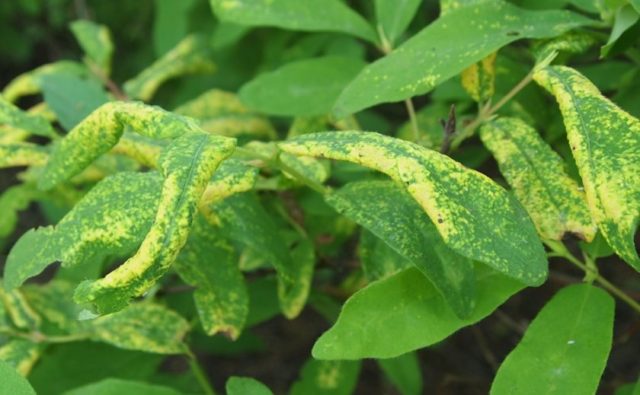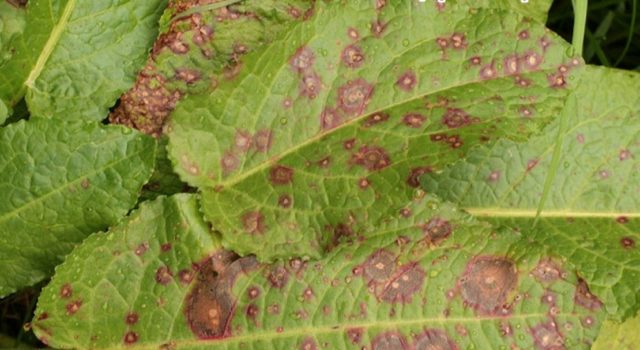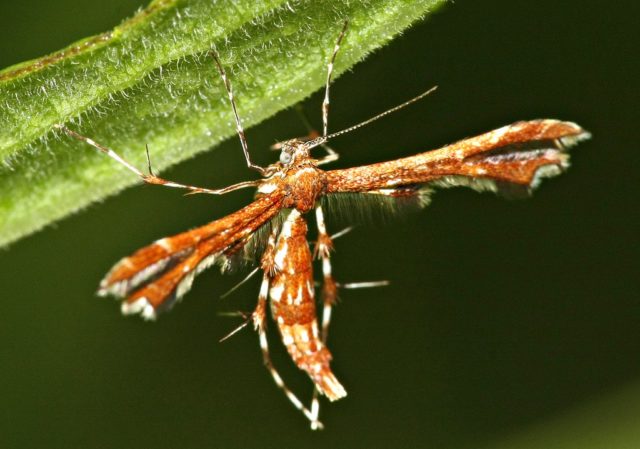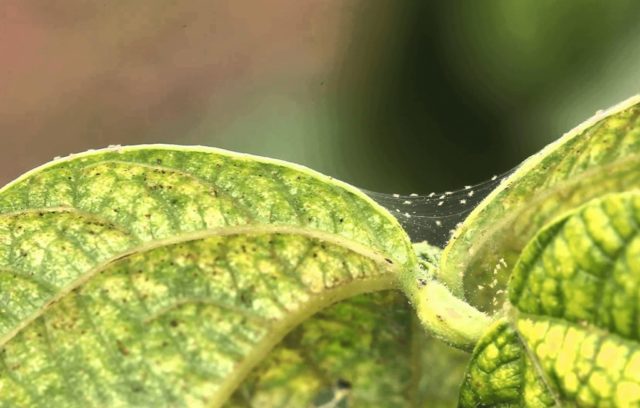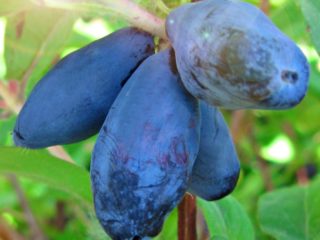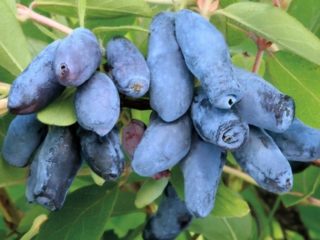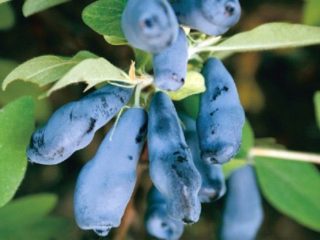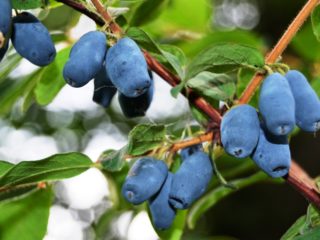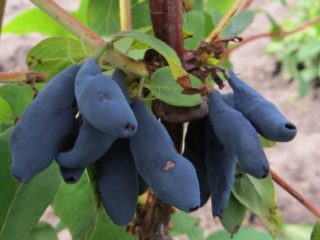Content
Honeysuckle is a healthy and tasty berry. Thanks to the work of scientists, a large number of varieties have been developed that differ in taste, ripening time, and winter hardiness. Description of the honeysuckle variety Fianit characterizes it as a powerful bush that pleases with a large harvest of healthy berries.
Description of the honeysuckle variety Fianit
Honeysuckle Fianit was bred by Russian scientists in 1995. After lengthy research, the plant was included in the State Register, and in 2002 it was classified as a Ural variety.
Acquaintance with honeysuckle Cubic zirconia should begin with external characteristics. It is a powerful, slightly spreading bush, 1-1.5 m high. The basal shoots are covered with large, ovoid leaves. In early summer, the plant is covered with large, pale yellow flowers. After flowering, fruits appear on the bush - oval-oblong berries weighing up to 1.5 g. The taste is dessert, sweet and sour, there is no bitterness.
Honeysuckle is a healthy berry.The fruits contain vitamins, microelements, pectins, tannins, sugar and organic acids. Due to its rich composition, the crop is used in the treatment of gastrointestinal and cardiovascular diseases, anemia, and hypertension.
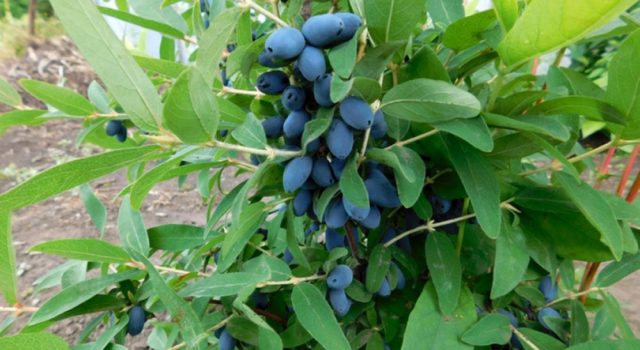
The berry of this variety is very large, the taste is dessert
Thanks to its positive characteristics, Fianit honeysuckle is popular not only in the Urals, but throughout Russia.
Distinctive features:
- Frost and drought resistance. The variety is cold-resistant; an adult bush can withstand temperatures down to -50°C without shelter. Honeysuckle is moisture-loving; with a lack of water, fruiting decreases, the berries become smaller and acquire a sour taste.
- Productivity. Honeysuckle Fianit is a medium-yielding variety. During the season, you can remove up to 2 kg of berries from the bush. Ripening is uniform, biological maturity occurs in mid-July. The harvest time depends on the growing region.
Like any plant, Fianit honeysuckle has strengths and weaknesses. The advantages include:
- cold resistance;
- immunity to diseases and pests;
- sweet, dessert taste;
- amicable maturation;
- resistance to shedding.
Gardeners consider the following disadvantages of the variety:
- average yield;
- late maturation.
Planting and caring for edible honeysuckle Fianit
Proper planting and care are the key to a high yield. If you follow agrotechnical rules, the plant will delight you with large and tasty fruits.
Landing dates
Honeysuckle flowers appear in early spring, before the soil warms up, so seedlings are removed into the ground in the fall, a month before the onset of frost. Spring planting is possible only if the purchased plant has a closed root system.
Selection and preparation of a landing site
Honeysuckle Fianit is an unpretentious variety and can grow anywhere.But to obtain a rich harvest of sweet berries, choose a site in the sun, protected from drafts and gusty winds.
The variety prefers to grow in nutritious, well-drained soil. Heavy clay and light sandy soil must be fertilized and mixed with peat and sand. When planted in a low area, where water will accumulate on rainy days, the plant may die from root rot.
In order for the bush to become not only a decoration for your garden plot, but also to bear fruit well, it is important to choose the seedling wisely.
When purchasing, pay attention to the following factors:
- The best survival rate of seedlings is 2-3 years old.
- Healthy planting material should have shoots that are flexible, brightly colored and have at least 3-4 healthy buds.
- The root system of a healthy plant is flexible and well developed. Overgrown roots are trimmed to 30 cm.
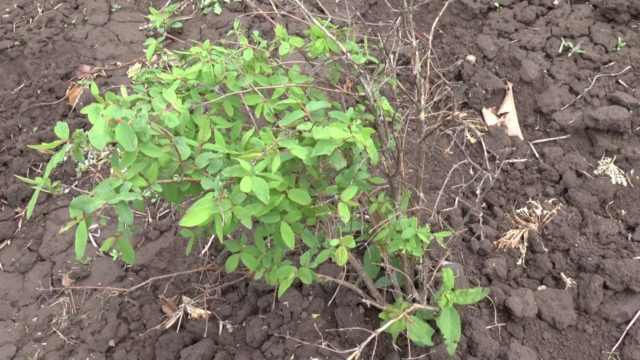
The plant prefers an open, sunny place
Landing rules
The future harvest depends on compliance with planting rules. It is carried out according to a certain scheme:
- Dig a hole measuring 40x40 cm.
- A drainage layer is laid on the bottom.
- The excavated soil is mixed with humus, wood ash and potassium sulfate. Everything is thoroughly mixed and transferred to a hole in the form of a mound.
- The roots of the seedling are straightened and placed on a prepared hill.
- The seedling is sprinkled with fertile soil, the top layer is compacted, spilled and mulched.
Watering and fertilizing
Honeysuckle Fianit is an unpretentious variety, but the better the bush is cared for, the richer the harvest will be. This is a moisture-loving crop; it is irrigated once a month.In hot, dry weather, watering is increased, since the lack of moisture affects the quality of the berries. Watering should be plentiful; at least a bucket of warm, settled water is used for each bush. After irrigation, the tree trunk circle is loosened and covered with leaves or straw.
In the first year after planting, honeysuckle does not need feeding. Next, fertilizers are applied 3 times a season:
- During the growing season, organic matter or a mineral complex with a predominance of nitrogen is used.
- After flowering, add a solution of nitrophoska (30 g per bucket of water) or slurry diluted 1:10.
- In autumn, the bush needs phosphorus and potassium, as these microelements will help it withstand severe frosts.
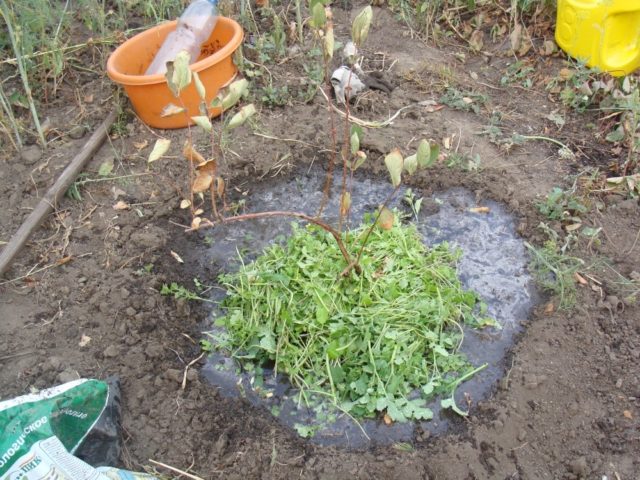
Watering is carried out with warm, settled water
Trimming
Honeysuckle Fianit needs rejuvenating and sanitary pruning. In the spring, before the sap flows, weak shoots that have not overwintered are cut out; you also need to get rid of the basal shoots that appear inside the bush, since the lack of light reduces the yield.
Old bushes are rejuvenated at the age of 10 years. To do this, remove all shoots, leaving only young shoots. To prevent diseases, the sections are treated with brilliant green or garden varnish.
Wintering
Honeysuckle Fianit is a cold-resistant variety, but in order not to lose the young plant, it is prepared for wintering. For this:
- The bush is watered generously and fed with wood ash.
- The trunk bush is mulched.
- The shoots are covered with agrofibre or spruce branches.
Reproduction of honeysuckle variety Fianit
Honeysuckle Fianit can be propagated by seeds, cuttings and dividing the bush:
- Seed propagation is a labor-intensive task and is used only in nurseries.
- Cuttings. In May, seedlings 7-10 cm long are cut from a healthy shoot. Each cutting should have 3-4 buds.The lower leaves of the planting material are removed, the upper ones are shortened by half. The cuttings are kept in a growth stimulator and planted in nutrient soil. In the spring, the young plant will begin to grow and by autumn it will be ready to be transplanted to a permanent place.
- Dividing the bush. A simple, effective method of propagation. To do this, dig up a bush 3-4 years old and divide it into a certain number of parts. Each division must have a developed root system and at least 3-4 shoots. Before planting, the roots are treated with Kornevin and the shoots are shortened. Prepared cuttings are planted in the fall in a well-lit place.
Pollinators of honeysuckle Fianit
Honeysuckle Fianit is not a self-fertile variety; without pollinators there will be no high fruiting. For a good harvest, several varieties are planted for cross-pollination. The interval between plantings should be at least 2.5 m. The best pollinator for Fianit honeysuckle is the Amphora variety.
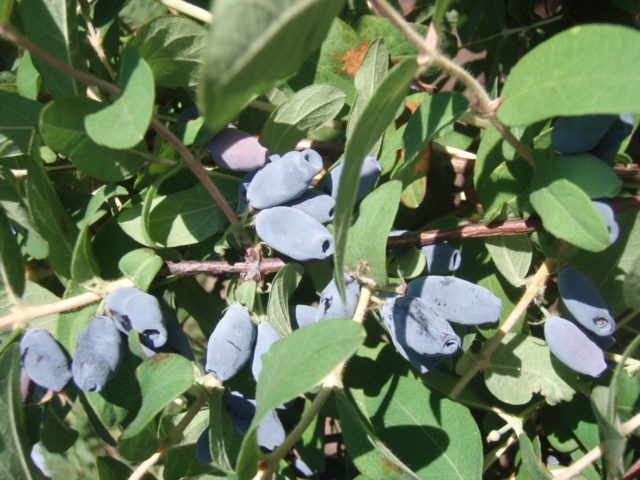
The Amphora variety is suitable as a pollinator
Diseases and pests
Honeysuckle Fianit is immune to diseases and pests. But if agricultural practices are not followed, the bush can be affected by the following ailments:
- Leaf mosaic - the disease manifests itself as light olive spots on the leaf blade. The virus is dangerous because it cannot be gotten rid of.
To prevent the disease from affecting neighboring crops, the bush is dug up and burned.
- Brown spot is a fungal disease that appears in mid-summer. The foliage becomes covered with brown spots, dries out and falls off. To destroy the fungus, honeysuckle is sprayed with Penconazole after harvesting.
Without treatment, the fungus quickly spreads to neighboring crops.
- The honeysuckle fingerwing is an insect that feeds on berries.If crooked, early-ripened fruits appear on the bush, it means that a pest has gotten to them. This crop is not used for food; it is collected and burned.
When damaged by a pest, the berries become deformed
- The spider mite, a pest, covers the entire aerial part with a thin film. When infected, the plant stops growing and developing.
The bush can be helped by the drug “Malathion”, which is used before flowering and after harvesting.
- Blackbirds - forest birds can destroy a crop in a short time. To protect the bush from birds, it is covered with a special bird net.
Blackbirds - lovers of eating ripe berries
Conclusion
Description of the honeysuckle variety Fianit reveals all the delights of the fruit crop. The plant is unpretentious and cold-resistant. With timely care, it will bear fruit and produce a tasty harvest for 30 years.
